Interview with Carlo Mazzi
Q: Carlo, you are not in real estate or tourism so why did you take on this project?
A: For more than 45 years, I held technical/professional or managerial roles in various industries: including aviation, financial services, academia, the cinema, investment banking, and fashion, but before finishing out my work life, I wanted to leave something tangible for future generations and for the city of Rome, which represents the original source of culture for every Italian (and for all people, to some extent).
I also wanted to be able to interact with people from all over the world: that is why I decided to establish my Roman home in the same building where our guest apartments are located.
Q: We know that you designed every detail, every single apartment, the atrium and all the common areas. What were the most important steps? The renovation took six years. Did you come up with all of the details for the project from the beginning or did you make changes as it took shape?
A: In the beginning, it was difficult to come up with a complete design because the building had been defaced over the previous centuries by various renovation projects that didn’t respect its history. At the same time, the constraints imposed the Superintendency had to be taken into account, and the areas hidden by superfluous additions – which concealed not only ancient artifacts but also structural problems – had to be restored. We uncovered secret rooms, painted ceilings covered with wallpaper, epigraphs, sculptures and ancient portals under plasterwork, and the two round windows in the centre of the facade obscured by masonry.
We demolished fake walls and various illegal spaces. Ironically, due to all of this, we actually had the active cooperation of the Superintendency of Cultural Heritage, which, among other things, wanted to get back to original colour of the façade hidden under several layers of paint: today, the original powder blue has returned as the calling card of this palazzo.
Obviously, we couldn’t have predicted all of this or much less plan for it beforehand. On the contrary, it was necessary to take things slowly by reworking the design to include and enhance each new discovery. Though it required a lot of time and resources, we were able to restore the dignity of this palazzo and its history; it dates back to the 15th Century, as evidenced by the two epigraphs on the facade.
Q: How did you come up with the name “Palazzo delle Pietre”? Obviously, this has to do with the fragments of ancient sculptures that show, in each and every environment, how passionate you are about objects of art, but what is their significance to you?
A: These ancient stones offer an escape from the unstoppable passing of time because they preserve the evidence of man’s work in the pursuit of beauty; art is a virtue that unites men and women from all over the world.”
Over the past 24 centuries, Rome has brought together the most beautiful sculptures in the world, and I wanted to use this name, along with my own modest collection of fragments, to pay homage to the history of this city and, at the same time, to allow everyone who would like to spend time in the Palazzo delle Pietre to share in the beauty of Rome.
